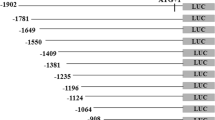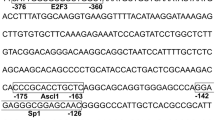Summary
The human aromatic L-amino acid decarboxylase (AADC) gene is transcribed in a tissue-specific manner by an alternative promoter. In this study using human cultured cell lines, we analyzed the alternative promoter that regulates tissue-specific expression of AADC. Neither neuronalnor nonneuronal-type mRNA of AADC was detected in HeLa cells, nonneuronal-type mRNA of AADC was expressed in HepG2 cells, and the neuronal-type was expressed in the SK-N-SH cell line. We examined the promoter activities located in 5′- and 3′-flanking regions of exon N1 and exon L1 by transfection experiments. Plasmids containing 5′-flanking regions of exon L1, the shortest of which was 0.3kb, could promote specifically high expression of the reporter gene in HepG2 cells. On the other hand, plasmids containing 5′-flanking regions of exon N1 (3.6 kb to 0.5 kb) could promote the reporter gene expression not only in SK-N-SH cells but also in HeLa and HepG2. More enhanced expression were observed by transfection of plasmids containing parts of the first intron in these cell lines. Thus, these results suggest that the basal liver-specific promoter activity is located in the 5′-flanking region of exon L1 and that the first intron may also be needed for enhanced expression rather than determination of cell-specificity.
Similar content being viewed by others
Abbreviations
- AADC :
-
aromatic L-amino acid decarboxylase
- DA :
-
Dopamine
- L-DOPA :
-
L-3,4,-dihydroxyphenylalanine
- L-5-HTP :
-
L-5-hydroxytryptophan
- 5-HT :
-
serotonine
- APUD :
-
amine precursor uptake and decarboxylation
- CAT :
-
chloramphenicolacetyltransferase
- RT-PCR :
-
reverse transcription-PCR
- EGTA :
-
ethylene glycol-bis (β-aminoethyl ether)-N, N, N′, N′-tetraacetic acid
- ONPG :
-
o-nitrophenyl-β-D-galactopyranoside
- RLU :
-
relative light unit
References
Albert VR, Lee MR, Bolden AH, Wurzburger RJ, Aguanno A (1992) Distinct promoters direct neuronal and nonneuronal expression of rat aromatic L-amino acid decarboxylase. Proc Natl Acad Sci USA 89: 12053–12057
Baylin SB, Abeloff MD, Goodwin G, Carney DM, Gazdar AF (1980) Activity of L-DOPA decarboxylase and diamine oxidase (histamine) in human lung cancers and decarboxylase as a marker for small (oat) cell carcinoma in cell culture. Cancer Res 40: 1990–1994
Bradford MM (1976) A rapid and sensitive method for the quantitation of microgram quantities of protein utilizing the principle of protein-dye binding. Anal Biochem 72: 248–254
Courtois G, Morgan JG, Campbell LA, Fourel G, Crabtree GR (1987) Interaction of a liver-specific nuclear factor with the fibrinogen and α1-antitrypsin promoters. Science 238: 688–692
Forss-Petter S, Danielson PE, Catsicas S, Battenberg E, Price J, Nirenberg M, Sutciffe JG (1990) Transgenic mice expressing \-galactosidase in mature neurons under neuronspecific enolase promoter control. Neuron 5: 187–197
González-Crespo S, Boronat A (1991) Expression of the rat growth hormone-releasing hormone gene in placenta is directed by an alternative promoter. Proc Natl Acad Sci USA 88: 8749–8753
Hahn SL, Hahn M, Kang UJ, Joh TH (1993) Structure of the rat aromatic L-amino acid decarboxylase gene: evidence for an alternative promoter usage. J Neurochem 60: 1058–1064
Hayashi M, Yamaji Y, Kitajima W, Saruta T (1990) Aromatic L-amino acid decarboxylase activity along the rat nephron. Am J Physiol 258: F28-F33
Ichinose H, Kurosawa Y, Titani K, Fujita K, Nagatsu T (1989) Isolation and characterization of a cDNA clone encoding human aromatic L-amino acid decarboxylase. Biochem Biophys Res Commun 164: 1024–1030
Ichinose H, Sumi-Ichinose C, Ohye T, Hagino Y, Fujita K, Nagatsu T (1992) Tissuespecific alternative splicing of the first exon generates two types of mRNAs in human aromatic L-amino acid decarboxylase. Biochemistry 31: 11546–11550
Ip YT, Granner DK, Chalkley R (1989) Hormonal regulation of phosphoenolpyruvate carboxykinase gene expression is mediated through modulation of an already disrupted chromatin structure. Mol Cell Biol 9: 1289–1297
Ishiguro H, Kim KT, Joh TH, Kim K-S (1993) Neuron-specific expression of the human dopamine β-hydroxylase gene requires both the cAMP-response element and a silencer region. J Biol Chem 268: 17987–17994
Jaeger CB, Teitelman G, Joh TH, Albert VR, Park DH, Reis DJ (1983) Some neurons of the rat central nervous system contain aromatic-L-amino-acid decarboxylase but not monoamines. Science 219: 1233–1235
Kraner SD, Chong JA, Tsay H-J, Mandel G (1992) Silencing the type II sodium channel gene: a model for neural-specific gene regulation. Neuron 9: 37–44
Le Van Thai A, Coste E, Allen JM, Palmiter RD, Weber WJ (1993) Identification of a neuron-specific promoter of human aromatic L-amino acid decarboxylase gene. Mol Brain Res 17: 227–238
Li X-M, Juorio AV, Boulton AA (1993) NSD-1015 alters the gene expression of aromatic L-amino acid decarboxylase in rat PC12 pheochromocytoma cells. Neurochem Res 18: 915–919
Li X-M, Juorio AV, Boulton AA (1994) Induction of aromatic L-amino acid decarboxylase mRNA by interleukin-1β and prostaglandin E2 in PC12 cells. Neurochem Res 19: 591–595
Lovenberg W, Weissbach H, Udenfriend S (1962) Aromatic L-amino acid decarboxylase. J Biol Chem 237: 89–93
McKnight SL, Lane MD, Gluecksohn-Waelsch S (1989) Is CCAAT/enhancer-binding protein a central regulator of energy metabolism? Genes Dev 3: 2021–2024
Morgan BA, Johnson WA, Hirsh J (1986) Regulated splicing produces different forms of dopa decarboxylase in the central nervous system and hypoderm of Drosophila melanogaster. EMBO J 5: 3335–3342
Mori N, Schoenherr C, Vandenbergh DJ, Anderson DJ (1992) A common silencer element in the SCG10 and type II Na+ channel genes binds a factor present in nonneuronal cells but not in neuronal cells. Neuron 9: 45–54
Morinaga T, Yasuda H, Hashimoto T, Higashio K, Tamaoki T (1991) A human α-fetoprotein enhancer-binding protein, ATBF1, contains four homeodomains and seventeen zinc fingers. Mol Cell Biol 11: 6041–6049
Nagatsu T, Ichinose H, Kojima K, Kameya T, Shimase J, Kodama T, Shimosato Y (1985) Aromatic L-amino acid decarboxylase activities in human lung tissues: comparison between normal lung and lung carcinomas. Biochem Med 34: 52–59
Nakajima-Iijima S, Hamada H, Reddy P, Kakunaga T(1985) Molecular structure of the human cytoplasmic β-actin gene: interspecies homology of sequences in the introns. Proc Natl Acad Sci USA 82: 6133–6137
Ow DW, Wood KV, DeLuca M, de Wet JR, Helinski DR, Howell SH (1986) Transient and stable expression of the firefly luciferase gene in plant cells and transgenic plants. Science 234: 856–859
Paranjape SM, Kamakaka RT, Kadonaga JT (1994) Role of chromatin structure in the regulation of transcription by RNA polymerase II. Annu Rev Biochem 63: 265–297
Pearse AGE (1969) The cytochemistry and ultrastructure of polypeptide hormone-producing cells of the APUD series and the embryologic, physiologic and pathologic implications of the concept. J Histochem Cytochem 17: 303–313
Sambrook J, Fritsch EF, Maniatis T (1989) Molecular cloning. A laboratory manual, 2nd edn. Cold Spring Harbor Laboratory, Cold Spring Harbor, New York
Sanger F, Nicklen S, Coulson AR (1977) DNA sequencing with chain-terminating inhibitors. Proc Natl Acad Sci USA 74: 5463–5467
Smith CWJ, Patton JG, Nadal-Ginard B (1989) Alternative splicing in the control of gene expression. Annu Rev Genet 23: 527–577
Sumi-Ichinose C, Hasegawa S, Ichinose H, Sawada H, Kobayashi K, Sakai M, Fujii T, Nomura H, Nomura T, Nagatsu I, Hagino Y, Fujita K, Nagatsu T (in press) Analysis of the alternative promoters that regulate tissue-specific expression of human aromatic L-amino acid decarboxylase. J Neurochem
Sumi-Ichinose C, Ichinose H, Takahashi E, Hori T, Nagatsu T (1992) Molecular cloning of genomic DNA and chromosomal assignment of the gene for human aromatic L-amino acid decarboxylase, the enzyme for catecholamine and serotonin biosynthesis. Biochemistry 31: 2229–2238
Vidal M, Morris R, Grosveld F, Spanopoulou E (1990) Tissue-specific control elements of the Thy-1 gene. EMBO J 9: 833–840
Author information
Authors and Affiliations
Rights and permissions
About this article
Cite this article
Sumi-Ichinose, C., Hasegawa, S., Ohtsuki, M. et al. Analysis of an alternative promoter that regulates tissue-specific expression of the human aromatic L-amino acid decarboxylase gene in cultured cell lines. J. Neural Transmission 103, 1–15 (1996). https://doi.org/10.1007/BF01292612
Received:
Accepted:
Issue Date:
DOI: https://doi.org/10.1007/BF01292612




